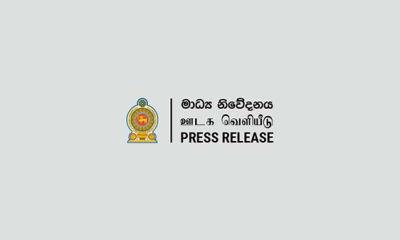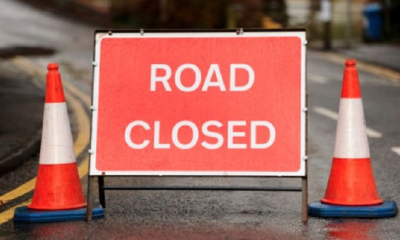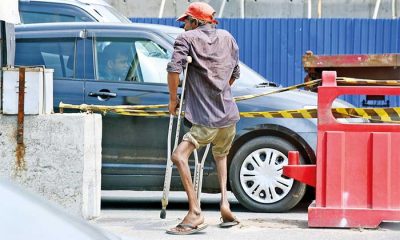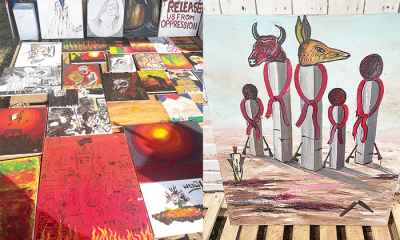Features
The changing faces of Galle Face
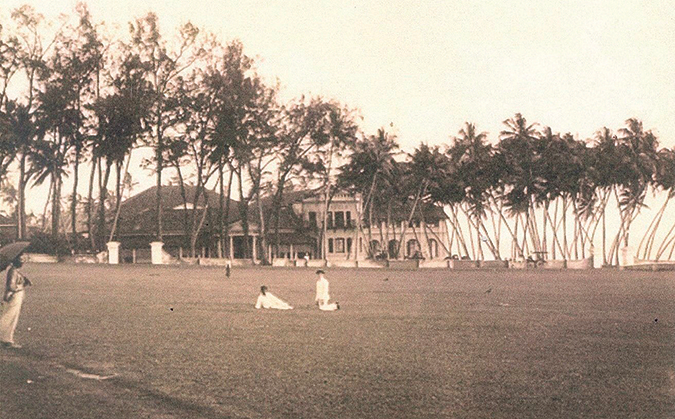
by Ismeth Raheem and Angeline Ondaatjie
Galle Face is Colombo’s most-prized open-aired public space, extending over a mile along the Fort oceanfront in Colombo. Over the course of Sri Lanka’s history, it has been the de facto stage for landmark public gatherings. Most recently over the months of April to July 2022, the Galle Face Green was the centerstage of the People’s Aragalaya, a protest movement that arose from economic hardship in Sri Lanka. During those weeks the protestors renamed it Gotagogama (GGG) and even had a Google marker to prove it. On July 9, 2022, unprecedented crowds from all parts of Sri Lanka gathered in the Galle Face Area breaking attendance records of Prime Minister D.S. Senanayake’s funeral in 1952, the 1953 hartal, and Pope Francis’s holy mass in 2015.
While it seems like it has been iconized by the Aragalaya over just the last few months, Galle Face’s rich history dates back centuries. Prior to the first fortifications that adorn it today (built by the Portuguese in the 16th century) it was referred to as Mapanne, meaning “large open plain”. Long before it became the open stretch of grassy plain sans trees/plants that we know it as, it was a large marsh land and part of the Colombo Lake (later known as the Beira Lake).
In this vast marshland, there were numerous small streams, ponds, and boulders. This extensive delta was created by numerous branches of the Kelani Ganga, the main river that flows to the sea by the ancient Kelani Temple, and is the third longest in the island. The Portuguese used the flooded areas as a defensive measure against possible attacks from the Kandyan Kingdom. Later the Dutch put their efforts into controlling and channeling the lake by creating a network of connected canals.
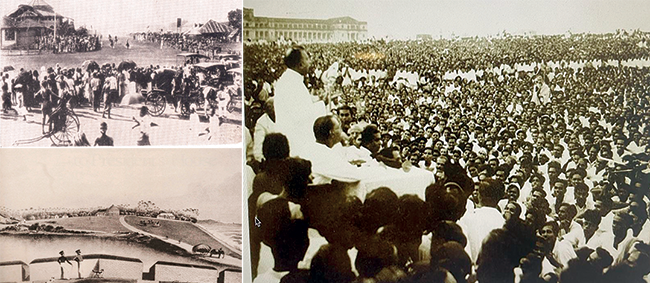
On the other hand, the British, who succeeded the Dutch in 1789, spent their efforts in reclaiming much of the lake area, believing that this would alleviate the flooding of Colombo’s low-lying areas. The original open stretch on the Southern side of the Fort (now known as Galle Face Esplanade) somehow gained more land around its periphery. Many of the new buildings that adorn the skyline of Slave Island (which owes its name to the slave tenements confined to a moat-surrounded land mass during the Dutch period) are in this reclaimed area of the Beira Lake.The open “Green” stretch was only seldom used for recreation under the Portuguese and Dutch occupations. This changed during the first decades of the 19th century, when it came into its own as the amusement, exercise, and sports venue that it is used as today.
The Galle Face Burial Grounds
Galle Face hosted the site of the first British burial grounds for over half a century from 1803, until the tombstones were translocated to the General Cemetery at Kanatte in 1877. This land may have been a part of the site that was reclaimed by the Dutch Administration of the East India Company around 1700-1750. [See Map of Colombo, 1750]. The timber palisade enclosing the cemetery and the tombstones are clearly indicated in the views of the Galle Face in the coloured engravings by John Deschamps [1848]. The burials were necessitated by the British army’s heavy military casualties from the wars with the King of Kandy during the administration of Governor North between 1801-1805.
For years, the Galle Face Cemetery was known as the “Padre Bailey’s Godown”, after the Archdeacon Bailey who officiated at the burials. J. P. Lewis’s “Tombstones and Monuments of Ceylon”, records the inscriptions on the headstones.
The open stretch of land outside the South Gate of the Colombo Fort was the site of military executions. In close proximity, at the northern end of the current esplanade, featured a guardhouse and a large block of wood: a “whipping post” where punishments were administered by public flogging.
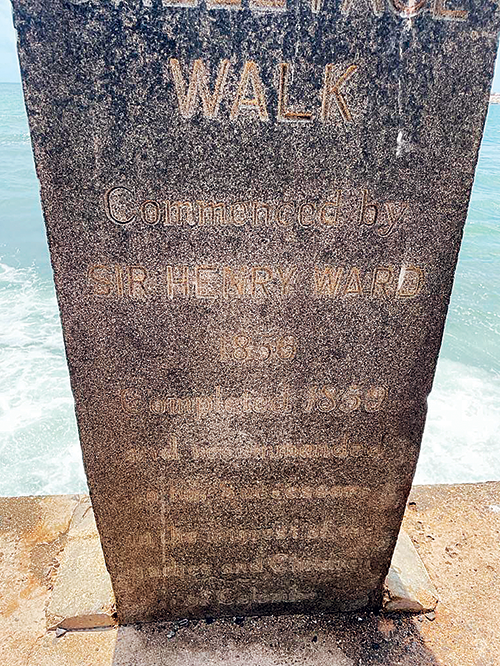
The Esplanade and the Recreation Galle Face Green
In 1853, the sea-front walk of the Galle Face was constructed by Governor Henry Ward. An inscription on the pillar midway through the walk still stands; it reads “Galle Face Walk completed in 1856 and recommended to his successors in the interest of the Ladies and Children of Colombo”.
Henry Charles, the author of “Ceylon and the Cingalese” compared Galle Face Green to Hyde Park in London. “At half past five the “Galle Face, or the Hyde Park of Colombo, begins to wear an animated appearance, there being many vehicles and horses in motion. Every description of conveyance to be seen driving around the Galle Face, from the Long Acre Built carriages of the Governor, the dashing phaeton of the wealthy merchant, the unassuming gig, the country- built palanquin and the humble bandy.”
The Galle Face Esplanade by John Deschamps shows the view from the ramparts of the Fort of Colombo facing the Galle Face Green. In the foreground are two Royal Military officers enjoying the scene. The Beira Lake, which was used for aquatic sports, the Round Pavilion, and Grand Stand of the Race Course are also in the background. The large bungalow towards the right of their view is the building that was later replaced by the Galle Face Hotel. The country house in the distant far right is the home of Governor Maitland, which later became the Mount Lavinia Hotel. The Race Bungalow, as the Grand Stand was later called, became The Colombo Club and still exists within the premises of the Taj Hotel.
In 1829, Sir Edward Barnes introduced horse racing at Galle Face after leveling a mile and a quarter of the grounds. While the upper floor of the conical-roofed race stand had the best views of the horse racing, it was also the venue for grand balls. The verandahs of the ball room were used for card playing, darts, and other favorite past times. By the 1830s, cricket and a whole host of Victorian sports and leisure activities were introduced and enjoyed by both the British and middle class locals, making it the most popular space in Colombo.
The Galle Face Railway Line Controversy (1873-75)
The railway line from Fort to the coast was originally planned to cut through the Galle Face Green. The Railway authorities set out an intended rail track from Maradana (the first railway station in Ceylon), Colombo Fort to Moratuwa cutting across Galle Face created a major controversy which involved the public, the legislative council, and the Governor of Ceylon.
The Times of Ceylon of Dec 4, 1873 stated – It is intended “to carry a line from a station to be constructed in the vacant plot near the Lotus Pond road, where passengers and goods from the Fort may be loaded, and where trains may run in connection with the railway station at Maradana; from the Fort Station, the line will diverge at the Police Station on the Galle Face, and skirt the sea-beach as far as Mount Lavinia”.
Public discontent at the impending desecration of the Galle Face walk soon became articulate – but the official trace by the railway planners did not appear to admit any change. On October 14, 1874, the Governor gave another version where he stated, “Inconvenience has been apprehended from trains running so near the road of the Galle Face, but care shall be taken that the train shall not run during evening”.
Some of the members of the Council were still discontent and by January 6, 1875 the tender notices for the construction of the Southern Line were published in the public press. The debate continued. The Government was prominently reminded of Sir Henry Ward’s recommendation of Galle Face to the Women and Children of Colombo by the Council and the public refused to be reconciled of this infringement. Yet the notices calling for tenders did not weaken the effort to save the Galle Face Walk.
The Council reminded the Governor of Galle Face’s dedication to the public and refused that it be desecrated and rendered unsafe by the “snorting and rattling and smoking vapours of the railway train”. The Governor responded by accepting the protest, since they represented the ladies of Colombo who were afraid that they will be deprived of their drive, and stated “I feel there is a good deal in this objection”.
On March 13, 1875, the Government took serious notice of the protests and assured the public that an alternate route will be used, which prompted the Observer in proclaiming in its issue of March 15, 1975: “GALLE FACE SAVED.”
Subsequently, the railway line from Fort as we see it today is connected to Compani Vidiya via an underground tunnel to the coast at Kollupitiya, honouring the decision to leave Galle Face Green untouched.The public recreation space and sacredness of Galle Face was saved, and allowed Sri Lankans to witness the historic mass independence rally on February 4, 1948. Radio Ceylon broadcasts were heard as far as Mount Everest, legendary school cricket matches, and most recently, the peaceful protests of the Aragalaya were also on Galle Face. The current legislators should learn their history and maintain the freedom and sanctity of this earth lung that is the only true free space in Colombo.
Features
The heart-friendly health minister

by Dr Gotabhya Ranasinghe
Senior Consultant Cardiologist
National Hospital Sri Lanka
When we sought a meeting with Hon Dr. Ramesh Pathirana, Minister of Health, he graciously cleared his busy schedule to accommodate us. Renowned for his attentive listening and deep understanding, Minister Pathirana is dedicated to advancing the health sector. His openness and transparency exemplify the qualities of an exemplary politician and minister.
Dr. Palitha Mahipala, the current Health Secretary, demonstrates both commendable enthusiasm and unwavering support. This combination of attributes makes him a highly compatible colleague for the esteemed Minister of Health.
Our discussion centered on a project that has been in the works for the past 30 years, one that no other minister had managed to advance.
Minister Pathirana, however, recognized the project’s significance and its potential to revolutionize care for heart patients.
The project involves the construction of a state-of-the-art facility at the premises of the National Hospital Colombo. The project’s location within the premises of the National Hospital underscores its importance and relevance to the healthcare infrastructure of the nation.
This facility will include a cardiology building and a tertiary care center, equipped with the latest technology to handle and treat all types of heart-related conditions and surgeries.
Securing funding was a major milestone for this initiative. Minister Pathirana successfully obtained approval for a $40 billion loan from the Asian Development Bank. With the funding in place, the foundation stone is scheduled to be laid in September this year, and construction will begin in January 2025.
This project guarantees a consistent and uninterrupted supply of stents and related medications for heart patients. As a result, patients will have timely access to essential medical supplies during their treatment and recovery. By securing these critical resources, the project aims to enhance patient outcomes, minimize treatment delays, and maintain the highest standards of cardiac care.
Upon its fruition, this monumental building will serve as a beacon of hope and healing, symbolizing the unwavering dedication to improving patient outcomes and fostering a healthier society.We anticipate a future marked by significant progress and positive outcomes in Sri Lanka’s cardiovascular treatment landscape within the foreseeable timeframe.
Features
A LOVING TRIBUTE TO JESUIT FR. ALOYSIUS PIERIS ON HIS 90th BIRTHDAY

by Fr. Emmanuel Fernando, OMI
Jesuit Fr. Aloysius Pieris (affectionately called Fr. Aloy) celebrated his 90th birthday on April 9, 2024 and I, as the editor of our Oblate Journal, THE MISSIONARY OBLATE had gone to press by that time. Immediately I decided to publish an article, appreciating the untiring selfless services he continues to offer for inter-Faith dialogue, the renewal of the Catholic Church, his concern for the poor and the suffering Sri Lankan masses and to me, the present writer.
It was in 1988, when I was appointed Director of the Oblate Scholastics at Ampitiya by the then Oblate Provincial Fr. Anselm Silva, that I came to know Fr. Aloy more closely. Knowing well his expertise in matters spiritual, theological, Indological and pastoral, and with the collaborative spirit of my companion-formators, our Oblate Scholastics were sent to Tulana, the Research and Encounter Centre, Kelaniya, of which he is the Founder-Director, for ‘exposure-programmes’ on matters spiritual, biblical, theological and pastoral. Some of these dimensions according to my view and that of my companion-formators, were not available at the National Seminary, Ampitiya.
Ever since that time, our Oblate formators/ accompaniers at the Oblate Scholasticate, Ampitiya , have continued to send our Oblate Scholastics to Tulana Centre for deepening their insights and convictions regarding matters needed to serve the people in today’s context. Fr. Aloy also had tried very enthusiastically with the Oblate team headed by Frs. Oswald Firth and Clement Waidyasekara to begin a Theologate, directed by the Religious Congregations in Sri Lanka, for the contextual formation/ accompaniment of their members. It should very well be a desired goal of the Leaders / Provincials of the Religious Congregations.
Besides being a formator/accompanier at the Oblate Scholasticate, I was entrusted also with the task of editing and publishing our Oblate journal, ‘The Missionary Oblate’. To maintain the quality of the journal I continue to depend on Fr. Aloy for his thought-provoking and stimulating articles on Biblical Spirituality, Biblical Theology and Ecclesiology. I am very grateful to him for his generous assistance. Of late, his writings on renewal of the Church, initiated by Pope St. John XX111 and continued by Pope Francis through the Synodal path, published in our Oblate journal, enable our readers to focus their attention also on the needed renewal in the Catholic Church in Sri Lanka. Fr. Aloy appreciated very much the Synodal path adopted by the Jesuit Pope Francis for the renewal of the Church, rooted very much on prayerful discernment. In my Religious and presbyteral life, Fr.Aloy continues to be my spiritual animator / guide and ongoing formator / acccompanier.
Fr. Aloysius Pieris, BA Hons (Lond), LPh (SHC, India), STL (PFT, Naples), PhD (SLU/VC), ThD (Tilburg), D.Ltt (KU), has been one of the eminent Asian theologians well recognized internationally and one who has lectured and held visiting chairs in many universities both in the West and in the East. Many members of Religious Congregations from Asian countries have benefited from his lectures and guidance in the East Asian Pastoral Institute (EAPI) in Manila, Philippines. He had been a Theologian consulted by the Federation of Asian Bishops’ Conferences for many years. During his professorship at the Gregorian University in Rome, he was called to be a member of a special group of advisers on other religions consulted by Pope Paul VI.
Fr. Aloy is the author of more than 30 books and well over 500 Research Papers. Some of his books and articles have been translated and published in several countries. Among those books, one can find the following: 1) The Genesis of an Asian Theology of Liberation (An Autobiographical Excursus on the Art of Theologising in Asia, 2) An Asian Theology of Liberation, 3) Providential Timeliness of Vatican 11 (a long-overdue halt to a scandalous millennium, 4) Give Vatican 11 a chance, 5) Leadership in the Church, 6) Relishing our faith in working for justice (Themes for study and discussion), 7) A Message meant mainly, not exclusively for Jesuits (Background information necessary for helping Francis renew the Church), 8) Lent in Lanka (Reflections and Resolutions, 9) Love meets wisdom (A Christian Experience of Buddhism, 10) Fire and Water 11) God’s Reign for God’s poor, 12) Our Unhiddden Agenda (How we Jesuits work, pray and form our men). He is also the Editor of two journals, Vagdevi, Journal of Religious Reflection and Dialogue, New Series.
Fr. Aloy has a BA in Pali and Sanskrit from the University of London and a Ph.D in Buddhist Philosophy from the University of Sri Lankan, Vidyodaya Campus. On Nov. 23, 2019, he was awarded the prestigious honorary Doctorate of Literature (D.Litt) by the Chancellor of the University of Kelaniya, the Most Venerable Welamitiyawe Dharmakirthi Sri Kusala Dhamma Thera.
Fr. Aloy continues to be a promoter of Gospel values and virtues. Justice as a constitutive dimension of love and social concern for the downtrodden masses are very much noted in his life and work. He had very much appreciated the commitment of the late Fr. Joseph (Joe) Fernando, the National Director of the Social and Economic Centre (SEDEC) for the poor.
In Sri Lanka, a few religious Congregations – the Good Shepherd Sisters, the Christian Brothers, the Marist Brothers and the Oblates – have invited him to animate their members especially during their Provincial Congresses, Chapters and International Conferences. The mainline Christian Churches also have sought his advice and followed his seminars. I, for one, regret very much, that the Sri Lankan authorities of the Catholic Church –today’s Hierarchy—- have not sought Fr.
Aloy’s expertise for the renewal of the Catholic Church in Sri Lanka and thus have not benefited from the immense store of wisdom and insight that he can offer to our local Church while the Sri Lankan bishops who governed the Catholic church in the immediate aftermath of the Second Vatican Council (Edmund Fernando OMI, Anthony de Saram, Leo Nanayakkara OSB, Frank Marcus Fernando, Paul Perera,) visited him and consulted him on many matters. Among the Tamil Bishops, Bishop Rayappu Joseph was keeping close contact with him and Bishop J. Deogupillai hosted him and his team visiting him after the horrible Black July massacre of Tamils.
Features
A fairy tale, success or debacle

Sri Lanka-Singapore Free Trade Agreement
By Gomi Senadhira
senadhiragomi@gmail.com
“You might tell fairy tales, but the progress of a country cannot be achieved through such narratives. A country cannot be developed by making false promises. The country moved backward because of the electoral promises made by political parties throughout time. We have witnessed that the ultimate result of this is the country becoming bankrupt. Unfortunately, many segments of the population have not come to realize this yet.” – President Ranil Wickremesinghe, 2024 Budget speech
Any Sri Lankan would agree with the above words of President Wickremesinghe on the false promises our politicians and officials make and the fairy tales they narrate which bankrupted this country. So, to understand this, let’s look at one such fairy tale with lots of false promises; Ranil Wickremesinghe’s greatest achievement in the area of international trade and investment promotion during the Yahapalana period, Sri Lanka-Singapore Free Trade Agreement (SLSFTA).
It is appropriate and timely to do it now as Finance Minister Wickremesinghe has just presented to parliament a bill on the National Policy on Economic Transformation which includes the establishment of an Office for International Trade and the Sri Lanka Institute of Economics and International Trade.
Was SLSFTA a “Cleverly negotiated Free Trade Agreement” as stated by the (former) Minister of Development Strategies and International Trade Malik Samarawickrama during the Parliamentary Debate on the SLSFTA in July 2018, or a colossal blunder covered up with lies, false promises, and fairy tales? After SLSFTA was signed there were a number of fairy tales published on this agreement by the Ministry of Development Strategies and International, Institute of Policy Studies, and others.
However, for this article, I would like to limit my comments to the speech by Minister Samarawickrama during the Parliamentary Debate, and the two most important areas in the agreement which were covered up with lies, fairy tales, and false promises, namely: revenue loss for Sri Lanka and Investment from Singapore. On the other important area, “Waste products dumping” I do not want to comment here as I have written extensively on the issue.
1. The revenue loss
During the Parliamentary Debate in July 2018, Minister Samarawickrama stated “…. let me reiterate that this FTA with Singapore has been very cleverly negotiated by us…. The liberalisation programme under this FTA has been carefully designed to have the least impact on domestic industry and revenue collection. We have included all revenue sensitive items in the negative list of items which will not be subject to removal of tariff. Therefore, 97.8% revenue from Customs duty is protected. Our tariff liberalisation will take place over a period of 12-15 years! In fact, the revenue earned through tariffs on goods imported from Singapore last year was Rs. 35 billion.
The revenue loss for over the next 15 years due to the FTA is only Rs. 733 million– which when annualised, on average, is just Rs. 51 million. That is just 0.14% per year! So anyone who claims the Singapore FTA causes revenue loss to the Government cannot do basic arithmetic! Mr. Speaker, in conclusion, I call on my fellow members of this House – don’t mislead the public with baseless criticism that is not grounded in facts. Don’t look at petty politics and use these issues for your own political survival.”
I was surprised to read the minister’s speech because an article published in January 2018 in “The Straits Times“, based on information released by the Singaporean Negotiators stated, “…. With the FTA, tariff savings for Singapore exports are estimated to hit $10 million annually“.
As the annual tariff savings (that is the revenue loss for Sri Lanka) calculated by the Singaporean Negotiators, Singaporean $ 10 million (Sri Lankan rupees 1,200 million in 2018) was way above the rupees’ 733 million revenue loss for 15 years estimated by the Sri Lankan negotiators, it was clear to any observer that one of the parties to the agreement had not done the basic arithmetic!
Six years later, according to a report published by “The Morning” newspaper, speaking at the Committee on Public Finance (COPF) on 7th May 2024, Mr Samarawickrama’s chief trade negotiator K.J. Weerasinghehad had admitted “…. that forecasted revenue loss for the Government of Sri Lanka through the Singapore FTA is Rs. 450 million in 2023 and Rs. 1.3 billion in 2024.”
If these numbers are correct, as tariff liberalisation under the SLSFTA has just started, we will pass Rs 2 billion very soon. Then, the question is how Sri Lanka’s trade negotiators made such a colossal blunder. Didn’t they do their basic arithmetic? If they didn’t know how to do basic arithmetic they should have at least done their basic readings. For example, the headline of the article published in The Straits Times in January 2018 was “Singapore, Sri Lanka sign FTA, annual savings of $10m expected”.
Anyway, as Sri Lanka’s chief negotiator reiterated at the COPF meeting that “…. since 99% of the tariffs in Singapore have zero rates of duty, Sri Lanka has agreed on 80% tariff liberalisation over a period of 15 years while expecting Singapore investments to address the imbalance in trade,” let’s turn towards investment.
Investment from Singapore
In July 2018, speaking during the Parliamentary Debate on the FTA this is what Minister Malik Samarawickrama stated on investment from Singapore, “Already, thanks to this FTA, in just the past two-and-a-half months since the agreement came into effect we have received a proposal from Singapore for investment amounting to $ 14.8 billion in an oil refinery for export of petroleum products. In addition, we have proposals for a steel manufacturing plant for exports ($ 1 billion investment), flour milling plant ($ 50 million), sugar refinery ($ 200 million). This adds up to more than $ 16.05 billion in the pipeline on these projects alone.
And all of these projects will create thousands of more jobs for our people. In principle approval has already been granted by the BOI and the investors are awaiting the release of land the environmental approvals to commence the project.
I request the Opposition and those with vested interests to change their narrow-minded thinking and join us to develop our country. We must always look at what is best for the whole community, not just the few who may oppose. We owe it to our people to courageously take decisions that will change their lives for the better.”
According to the media report I quoted earlier, speaking at the Committee on Public Finance (COPF) Chief Negotiator Weerasinghe has admitted that Sri Lanka was not happy with overall Singapore investments that have come in the past few years in return for the trade liberalisation under the Singapore-Sri Lanka Free Trade Agreement. He has added that between 2021 and 2023 the total investment from Singapore had been around $162 million!
What happened to those projects worth $16 billion negotiated, thanks to the SLSFTA, in just the two-and-a-half months after the agreement came into effect and approved by the BOI? I do not know about the steel manufacturing plant for exports ($ 1 billion investment), flour milling plant ($ 50 million) and sugar refinery ($ 200 million).
However, story of the multibillion-dollar investment in the Petroleum Refinery unfolded in a manner that would qualify it as the best fairy tale with false promises presented by our politicians and the officials, prior to 2019 elections.
Though many Sri Lankans got to know, through the media which repeatedly highlighted a plethora of issues surrounding the project and the questionable credentials of the Singaporean investor, the construction work on the Mirrijiwela Oil Refinery along with the cement factory began on the24th of March 2019 with a bang and Minister Ranil Wickremesinghe and his ministers along with the foreign and local dignitaries laid the foundation stones.
That was few months before the 2019 Presidential elections. Inaugurating the construction work Prime Minister Ranil Wickremesinghe said the projects will create thousands of job opportunities in the area and surrounding districts.
The oil refinery, which was to be built over 200 acres of land, with the capacity to refine 200,000 barrels of crude oil per day, was to generate US$7 billion of exports and create 1,500 direct and 3,000 indirect jobs. The construction of the refinery was to be completed in 44 months. Four years later, in August 2023 the Cabinet of Ministers approved the proposal presented by President Ranil Wickremesinghe to cancel the agreement with the investors of the refinery as the project has not been implemented! Can they explain to the country how much money was wasted to produce that fairy tale?
It is obvious that the President, ministers, and officials had made huge blunders and had deliberately misled the public and the parliament on the revenue loss and potential investment from SLSFTA with fairy tales and false promises.
As the president himself said, a country cannot be developed by making false promises or with fairy tales and these false promises and fairy tales had bankrupted the country. “Unfortunately, many segments of the population have not come to realize this yet”.
(The writer, a specialist and an activist on trade and development issues . )


